We can bet a good amount that all of us (even ourselves!!) have tried to look into new and more efficient ways of getting work done. Whether it’s new studying techniques like the Pomodoro method or new memorization tactics, we’ve all tried to get our hands on a few good techniques to help us in our exams!
This chapter may actually be one of the more beneficial ones for y’all in regard to your MCAT prep, as you’ll perhaps pick up on some techniques and strategies that might help you when you’re reviewing for the MCAT!
Hopefully, after going through this chapter overview, you’ll be more comfortable with some of the main topics in learning and memory. Let’s get started!
Learning and Memory on the MCAT: What You Need to Know
Topics on language and memory will be tested on the Psych/Soc section of the MCAT and can appear both as passage based and fundamental discrete questions.
If you can, try to focus a bit more on this section as this is one of the more high yield sections on the MCAT — we’ve averaged that you can expect around 9 -11 questions covering learning and memory, give or take.
Introductory psychology accounts for 65% of the content covered in the Psychological, Social, and Biological Foundations of Behavior, while introductory sociology covers about 30 of the content.
Important Sub-Topics: Learning and Memory
As with many psychological topics, we’ll go ahead and highlight both the neurobiological basis of learning and memory while also getting in touch with their more abstract components that aren’t as tangible.
Take advantage of this section! You won’t be studying this material just for the sake of MCAT prep, but you can also utilize and apply the things you learn in all facets of your studying: for midterms, finals, and of course, the MCAT!
1. Types of Associative Learning
Before getting into the main types of associative learning, let’s first define the term learning. Though we think of learning as students studying in the classroom or at a desk, psychologists go a different route and define learning as the acquiring of a new behavior as a result of an experience, observation, activity, etc.
Associative learning is a type of learning where new behavior is acquired by pairing 2 unrelated elements — these can be events, objects, sounds, etc.! Eventually, when the 2 elements become, the individual becomes conditioned. Look at the example below!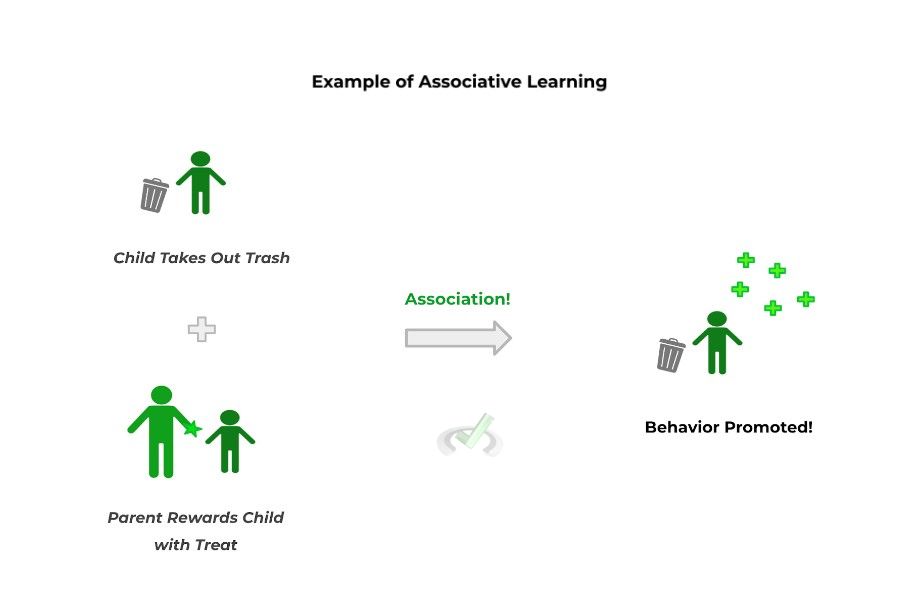
There are 2 main types of associative learning that the MCAT will focus on classical conditioning and operant conditioning. If you’ve taken an introductory psychology course, you may be familiar with this concept in the context of Pavlov’s dog.
Pavlov noticed that there was a reflexive salivation when the dog was shown a slab of meat Here, we call the meat the unconditioned stimulus and the salivation as the unconditioned response because we didn’t have to train the dog to salivate when shown the meat — everything was natural and reflexive!
Pavlov then began to ring a bell before presenting the meat. Initially, the dog didn’t salivate when it heard the bell ring and only salivated when the meat was presented after. At this point, the bell ring is considered a neutral stimulus as it prompted no response from the dog!
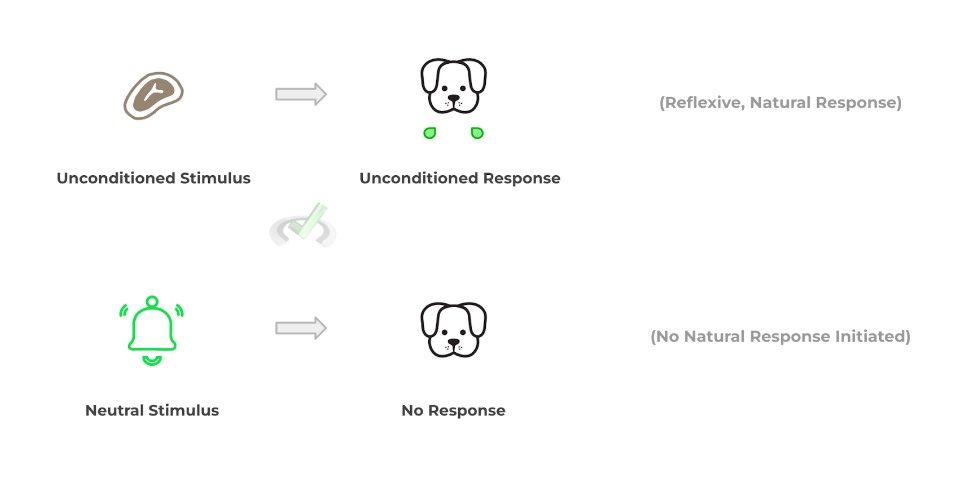
However, over time, the dog begins to associate the bell ring with the upcoming presentation of the meet. As a result, the dog begins to salivate just by the stimuli of the bell! Now, the bell ring (originally a neutral stimulus) becomes a conditioned stimulus paired with the conditioned response of salivation!
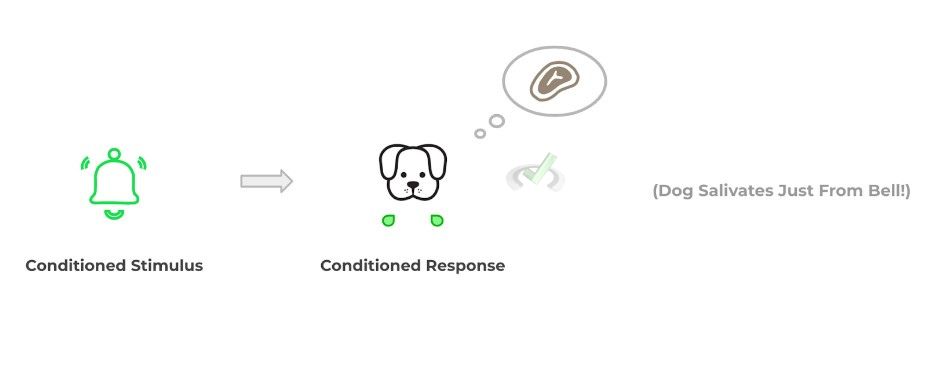
We term it conditioned because the dog has been trained (kinda like conditioning training in running) to associate the bell ring with the meat and is now trained to salivate from just hearing the bell!
Note also that the unconditioned and conditioned responses are the same — salivation! They just differ in what stimulates that response: the unconditioned response is stimulated by the unconditioned stimulus and the conditioned response is stimulated by the conditioned stimulus!
Operant conditioning is similar to classical conditioning but takes things a step further: operant conditioning can allow for both the promotion (or discouragement) of behavior by using rewarding and punishment conditions.
This type of learning is first divided into whether we’re trying to promote or discourage a behavior, specifically called reinforcement and punishment. These can be further divided into whether something is “added” (positive) or “subtracted” (negative). Take a look at the figure below!
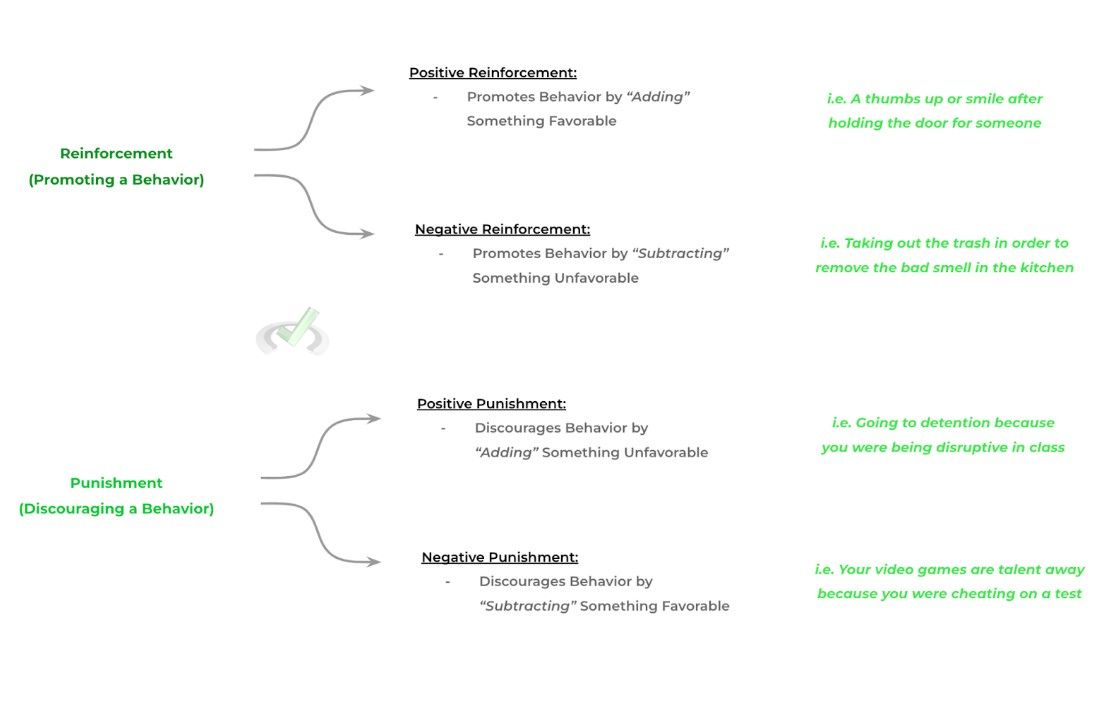
Full Study Notes : Types of Associative Learning
For more in-depth content review on types of associative learning, check out these detailed lesson notes created by top MCAT scorers.
2. Observational Learning
In some cases, learning can be a bit more direct, as in the case of observational learning — as indicated by the name, this theory highlights the importance of observing other individuals perform a behavior in order to learn that behavior. Additionally, this theory also supports the need for socialization in order for observation to occur.
One of the pioneering psychologists to investigate this type of learning is Albert Bandura who is perhaps most well-known for his Bobo doll experiment (this was an old, blow-up doll back in the day!).
The experiment provides support for observational learning given the findings: in the experiment, a group of kids watched an adult being violently aggressive towards the Bobo doll — punching, kicking, strangling, etc. When the kids were given the doll, they found that they tended to also participate in violent behavior towards the doll.
However, it should be noted that whether or not an individual will partake in observed behavior is also affected by other factors, such as the observed consequence of a behavior and the image/likeness of the individual!
For example, when the kids observed the adult getting scolded after partaking in violent behavior, they were less likely to engage in the same behavior. Additionally, if an individual looks up to another individual — like a basketball player — and wishes to “be like them”, they mimic the way that acts!
The individual may do the same drills and workouts, have similar celebrations after a big shot, and might approach the game with the same mentality (and the only right one is the Mamba Mentality!!).
Full Study Notes : Observational Learning
For more in-depth content review on observational learning, check out these detailed lesson notes created by top MCAT scorers.
3. Process of Memory Formation
While we’re all familiar with the memories we make — from making a mnemonic for the Krebs cycle or the ones you made with friends in Hawaii — let’s define what a memory is in the first place! Memory can be generally thought of as the ability to take new information and turn it into something we can remember.
The 3 main processes that are associated with memory are encoding, storage, and retrieval, with each step occurring in this sequential order: information is encoded to be stored as a memory which can later be retrieved if required!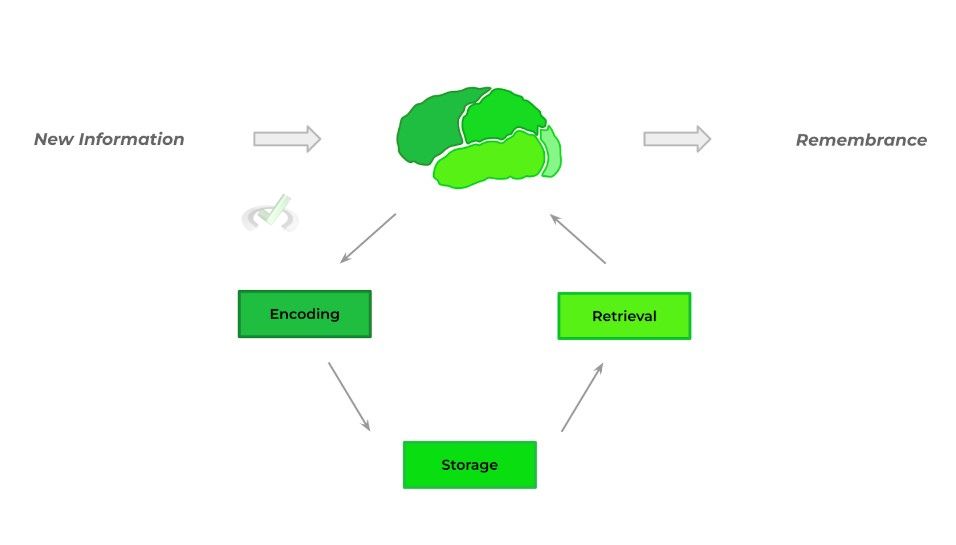
There are several methods and strategies which can improve the process of encoding, called mnemonic devices. One common method is called chunking and works especially well for lists! Instead of memorizing a straight list of 9 numbers, you can instead break or “chunk” them up into groups of 3.
Another common mnemonic technique is utilizing word acronyms and associations. You can memorize a list of word items by coming up with a word where each letter of the word correlates to the first letter of the list item — you can alternatively use a phrase instead of a single word!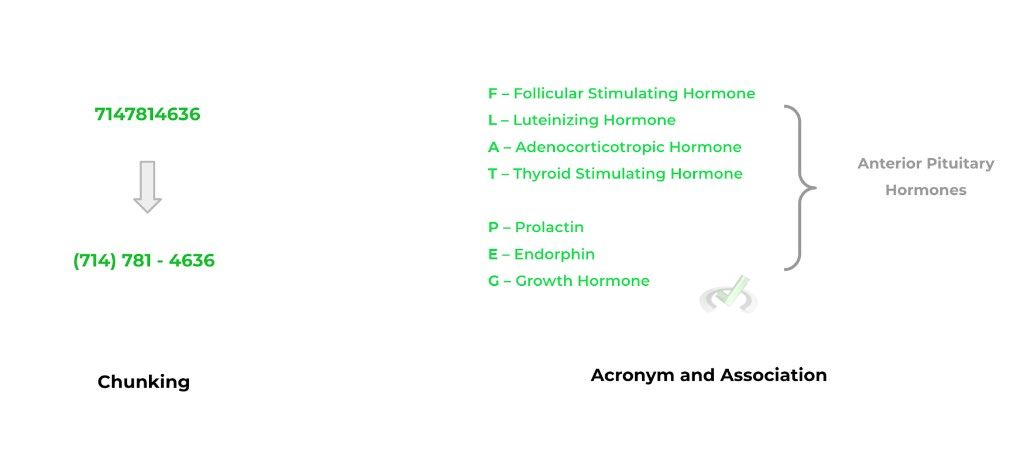
We’ll go in much more detail about the different types of memory storage in the next section; for now, just know that the 2 main categories of memory: short term and long term memory — again, we’ll go more into this in the next section!
A big component of retrieval information stored as memory is the reliance on cues, which are similar to mnemonics, as they are tools we can use to help in the retrieval of a memory!
One example of a retrieval cue is priming which relies on the idea of a semantic network! A semantic network is a set of closely related ideas/concepts that are connected with one another — try to think of it kinda like a spider web, as shown below!

When one word/concept is mentioned, the node becomes “activated and triggered”! Once this node is activated, it allows for the activation of similar “surrounding” nodes which in turn will activate other nodes and so on — this domino-like, downstream activation within a semantic network is called spreading activation!
Priming takes advantage of the spreading activation that occurs in a semantic network: by utilizing a related node as a retrieval cue, we can hopefully get elicit the retrieval of memory by triggering its activation in the semantic network!
Full Study Notes : Process of Memory Formation
For more in-depth content review on the main process involved in memory, check out these detailed lesson notes created by top MCAT scorers.
4. Types of Memory Storage
As we stated above, there are various types of memory storage and is best described as a 3-box model. In this model, the different types of memory storage are depicted as “boxes,” and in order to move from one box to another depends on how the incoming information is focused on and processed.
The 3 main types of memory organized into the boxes are sensory, short term, and long term memory. Sensory memory is regarded as the weakest storage of memory, while long term memory is regarded as the strongest!
Again, where the information is put in regards to memory storage — sensory, short term, or long term — depends on how the information is processed and attended to (i.e., how much and the type of focus given towards it).
As shown above, conscious attention to information in sensory memory allows for it to be moved to short term memory. Likewise, the encoding of information in short term memory allows it to be moved into long term memory.

Sensory memory refers to the memory storage of all incoming visual (iconic) and auditory (echoic) sensory information and is the most fleeting, lasting only about 1-5 seconds.
Short term memory lasts a little longer — about 15 - 30 seconds — before being forgotten. A tool called maintenance rehearsal can help keep information in short term memory by simply repeating it to keep it at the forefront of cognitive attention. Think of yourself repeating a phone number before writing it down!
Long term memory is theoretically limitless and can be primarily divided into 2 categories: explicit and implicit. The former refers to memories that you must “actively” try to remember, such as facts, while the latter refers to memories (more so learned skills) that don’t require conscious effort to recall such as riding a bike!
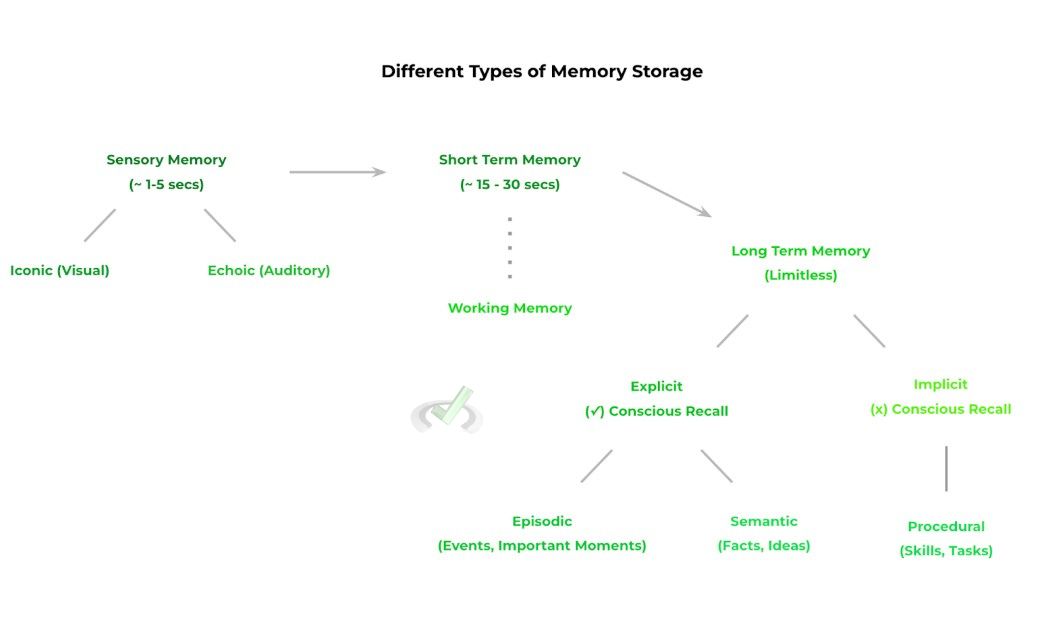
You probably noticed that there were a couple of other memory subsets listed in the diagram above. We’ll go into much more detail about these different subsets in a more specialized article found in this article!
Full Study Notes : Types of Memory Storage
For more in-depth content review on the types of memory storage, check out these detailed lesson notes created by top MCAT scorers.
5. Biological Basis of Learning and Memory Formation
Similar to a lot of psychological topics, we can attribute some of the findings and observations to a neurobiological basis! At a cellular level, learning and memory formation can be attributed to the formation and strengthening of neural pathways which are activated to form and retain what’s been learned and memorized!
One of the main factors behind this is the brain’s neuroplasticity which refers to its ability to “reshape” and adapt in response to new incoming information! 2 examples of neuroplasticity are synaptic pruning and long term potentiation.
A great way to view these 2 concepts is that they oppose each other: synaptic pruning refers to the weakening of neural pathways that aren’t given as much activation while long term potentiation results in the strengthening of neural pathways that are greatly stimulated!
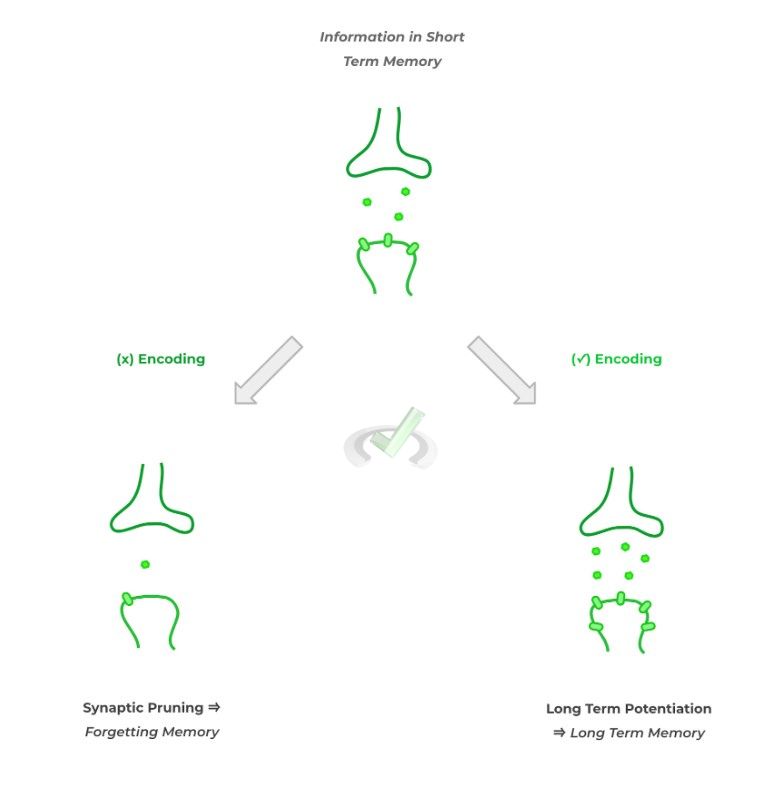
As shown above, it’s thought that synaptic pruning and long term potentiation are the basis for the forgetting of short term memory and conversion of short term memory to long term memory, respectively!
When short term memory is not attended to, synaptic pruning occurs, which results in the memory being lost; conversely, the encoding of short term memory results in long term potentiation and allows for that memory to be moved into long term memory!
Full Study Notes : Biological Basis of Learning and Memory Formation
For more in-depth content review on biological basis of learning and memory formation, check out these detailed lesson notes created by top MCAT scorers.
Important Definitions and Key Terms
Below are some high yield definitions and key terms to refer to when reviewing concepts and ideas about learning and memory.
Term | Definition |
|---|---|
Associative Learning | A type of learning strategy that relies on the association and pairing of 2 unrelated elements, which eventually become conditioned |
Classical Conditioning | A type of associative learning which allows for a behavior to be learned by eventually turning a neutral stimulus into a conditioned stimulus |
Operant Conditioning | A type of associative learning which allows for a behavior to be learned via the use of reinforcement and punishment tactics |
Reinforcement | A condition in operant conditioning which works to promote a certain behavior into being learned |
Punishment | A condition in operant conditioning which works to inhibit/prevent a certain behavior from being learned |
Observational Learning |
Another type of learning which relies heavily on the observation of others in order to learn a behavior; A great example of this is Bandura’s Bobo Doll experiment |
Encoding |
The process in memory formation where meaning is associated/formed within incoming new information |
Storage |
The process in memory formation where memory is stored either into sensory, short, or long term memory |
Retrieval |
The process by which memories are retrieved from memory storage |
Mnemonic Devices |
Methods and strategies which are employed in order to aid in the process of encoding |
Semantic Network |
A collection similarly related ideas/concepts which are connected with one another; Each idea/concepts is viewed as a node |
Spreading Activation |
Refers to the idea that once one node in a semantic network is activated, all other nodes within the network are also similarly activated |
Neuroplasticity |
Refers to the brain’s ability to adapt to new incoming information from many aspects such as in structural, biochemical, cellular aspects |
Synaptic Pruning |
The process by which lowly activated neural pathways are weakened; this is one example of the brain’s neuroplasticity |
Long Term Potentiation |
The process by which highly activated neural pathways are strengthened; this is another example of the brain’s neuroplasticity |
Additional FAQs - Learning and Memory on the MCAT
A. What is Working Memory – MCAT?
To give an example, suppose a recipe for cookies requires 3 cups of sugar. Working memory is in play when you’re trying to remember the fact that you already put in 2 cups and that you only need to add one more cup as you’re refilling the sugar.



 To help you achieve your goal MCAT score, we take turns hosting these
To help you achieve your goal MCAT score, we take turns hosting these 
























